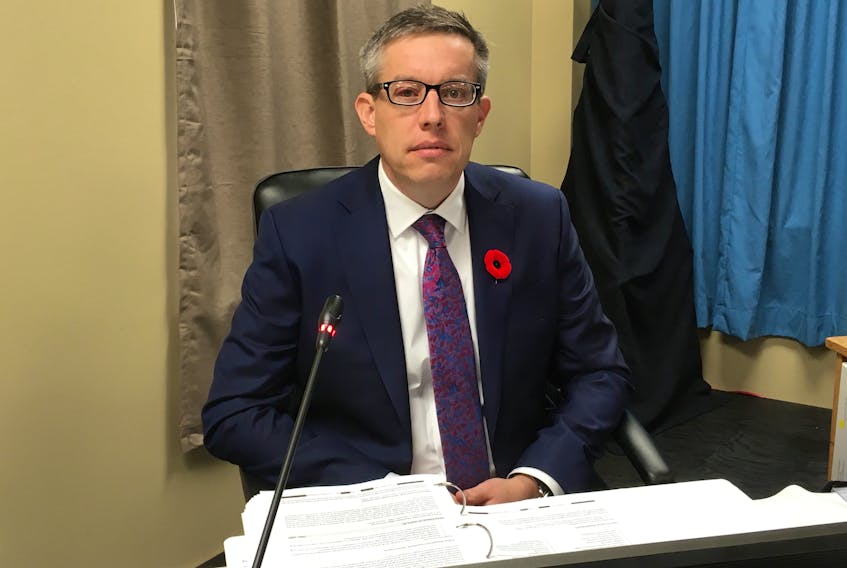A briefing document summarizing the story behind the Muskrat Falls hydroelectric project’s sanctioning — developed by Nalcor Energy for its legal counsel McInnes Cooper — was referenced again at the Muskrat Falls Inquiry on Wednesday.
The inquiry heard from Jason Kean, a former deputy project general manager and one of the primary authors of the briefing document.
Kean was asked to read a passage from the report aloud.
“The $6.2 billion value would become the project sanction or original DG3 project control budget, and contained a P50 estimate contingency with no provision for strategic risk, time risk or foreign exchange risk,” it stated.
The inquiry has heard the “strategic risk” not included has been estimated at about $500 million.
“The $6.2 billion was internally characterized by the project team as an aggressive cost basis because there was no provision for the identified strategic risk exposure,” Kean said on the stand, reading from the document.
The inquiry was told an amount to cover strategic risk was removed during negotiations with Emera, given the amount could be brought back and considered in the final, public cost estimate for Newfoundland and Labrador.
“This, however, did not occur due to the desire of Nalcor Executive to maintain the estimate at $6.2 billion,” Kean read.
Responding to questions from inquiry co-counsel Kate O’Brien, he clarified the “Nalcor Executive” referred to was “primarily to Mr. (Gilbert) Bennett and Mr. (Ed) Martin.” And when he talked about the project management team, he meant team members such as Paul Harrington, Lance Clarke, Scott O’Brien, Ron Power and potentially others.
He said the $6.2-billion figure heard in 2012 did include an estimate for contingency, but confirmed it did not address all of the risk exposure on the project.
While some of the identified risks were “heavily mitigated,” Kean said, it was possible there was “some unquantified or unknown event that might occur,” but with no dollars factored in to cover it.
Kean said he understood the shareholder, the provincial government, would ultimately “backstop” the project and cover the bill, if risk turned to reality.
He said Bennett and Martin were aware of the additional risks, outside of what was covered by the public estimate, and other members of the project management team were as well, but he couldn’t speak to the level of knowledge of the other Nalcor Energy executives such as chief financial officer Derrick Sturge or the Nalcor Energy board of directors.
Kean presented information to Manitoba Hydro International (MHI) and Independent Project Review (IPR), during their Muskrat Falls reviews. But the inquiry has been presented with evidence MHI was not addressing project risk in detail as part of its tasks and the IPR findings were not included in any detail in the final “decision gate three” package sent to the Nalcor board.
“As I said, I recall (Bennett and Martin) because I had some direct engagement presenting to those, but how that information flowed after I presented it, I have no idea really,” Kean said.
‘Not perfect’
He was also asked about a report provided to him by John Hollmann of Validation Estimating LLC, looking at the “decision gate three” capital cost estimate. The report was dated April 9, 2012.
It was marked “DRAFT” and Kean said there never was a final version submitted, as he cut off further review. He described it as simply a check he wanted, a “peer review.” And, “I felt we had what we needed,” Kean said, of why a final report wasn’t sought.
O’Brien asked about how the draft report was used. She noted a quote appearing on Nalcor Energy presentation slides, describing the Muskrat Falls cost estimate as “one of the best mega-project ‘base’ estimates” seen in some time.
Kean said he couldn’t speak to everywhere that comment may have been used.
He acknowledged it wasn’t noted that it was from a draft report.
In full, the quote reads, “First, it should be noted that while not perfect, the (project) estimate in its current state is one of the best mega-project ‘base’ estimates that this reviewer has seen in some time.”
O’Brien highlighted the “not perfect” in questions. She suggested — as apparently the report wasn’t widely circulated — people such as former Finance minister Tom Marshall and the Nalcor Energy board of directors would also not have heard the more critical comments on “obfuscation” by the project team through use of non-standard terms, “confusing” references to risks, and “weak logic in treatment of risk costs,” with no reserve amounts set aside for some risks to the project that were 100 per cent probable.
Kean is back for an early start (9 a.m. NT) Thursday, to finish examination with O’Brien and begin cross-examination. He is the last witness scheduled for the week.
RELATED STORY:
The Muskrat Falls Inquiry









